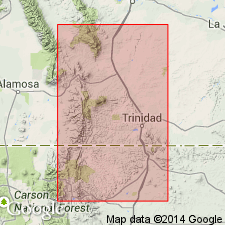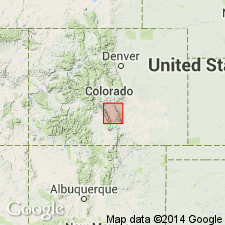
- Usage in publication:
-
- Farisita conglomerate*
- Modifications:
-
- Named
- Dominant lithology:
-
- Sandstone
- Siltstone
- AAPG geologic province:
-
- Las Vegas-Raton basin
Summary:
Named for exposures along Turkey Creek, north of the town of Farisita, Huerfano Co., CO in the Las Vegas-Raton basin. No type locality reported because outcrops are scarce and discontinuous. Formerly mapped as part of the older Huerfano formation, but Farisita rocks are very different from the Huerfano. Is a buff conglomeratic sandstone and siltstone. Individual beds are lenticular and cross-laminated. Conglomerate, which is mostly from pre-Cambrian and from some Jurassic and Permian, ranges from pebbles to 8 ft boulders, subangular to rounded, very poorly sorted and poorly cemented. Occurs entirely in Huerfano Park. Ranges in thickness from thin edge to about 1,200 ft. Unconformably overlies Huerfano; unconformably underlies Devil's Hole formation (new name). Holds up rough terrane; forms landslides on steep slopes. Bone fragments and plant remains found. Tentatively assigned to Oligocene.
Source: GNU records (USGS DDS-6; Denver GNULEX).

- Usage in publication:
-
- Farisita Conglomerate*
- Modifications:
-
- Overview
- AAPG geologic province:
-
- Las Vegas-Raton basin
Summary:
Named applied to yellowish-gray coarse conglomerate and sandstone derived chiefly from granitic crystalline rocks in the Wet Mountains. Thought to be the lateral equivalent of Huerfano Formation (which is a red sandstone and mudstone derived from Permian and Pennsylvanian rocks in the Sangre de Cristo Range), and of the Cuchara Formation (which is a mixture of Huerfano and Farisita lithologies). These three lithologies would be best considered facies of one formation rather than three individual formations. Mapped with Huerfano and Cuchara Formations in Huerfano Park, Huerfano Co, CO in the Las Vegas-Raton basin. Assigned an Eocene age.
Source: GNU records (USGS DDS-6; Denver GNULEX).
For more information, please contact Nancy Stamm, Geologic Names Committee Secretary.
Asterisk (*) indicates published by U.S. Geological Survey authors.
"No current usage" (†) implies that a name has been abandoned or has fallen into disuse. Former usage and, if known, replacement name given in parentheses ( ).
Slash (/) indicates name conflicts with nomenclatural guidelines (CSN, 1933; ACSN, 1961, 1970; NACSN, 1983, 2005, 2021). May be explained within brackets ([ ]).

